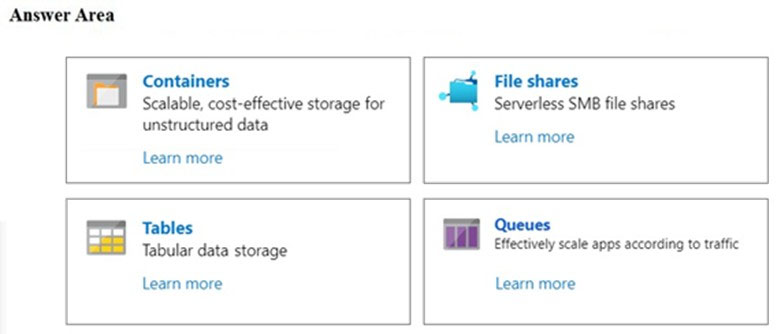| Question.41 Note: This question is part of a series of questions that present the same scenario. Each question in the series contains a unique solution that might meet the stated goals. Some question sets might have more than one correct solution, while others might not have a correct solution. After you answer a question in this section, you will NOT be able to return to it. As a result, these questions will not appear in the review screen. Your company plans to migrate all its data and resources to Azure. The company’s migration plan states that only Platform as a Service (PaaS) solutions must be used in Azure. You need to deploy an Azure environment that meets the company migration plan. Solution: You create an Azure App Service and Azure SQL databases. Does this meet the goal? (A) Yes (B) No |
41. Click here to View Answer
Answer : A
Azure App Service and Azure SQL databases are examples of Azure PaaS solutions. Therefore, this solution does meet the goal.
| Question.42 You plan to create an Azure virtual machine. You need to identify which storage service must be used to store the unmanaged data disks of the virtual machine. What should you identify?  (A) Containers (B) File shares (C) Tables (D) Queues |
42. Click here to View Answer
Answer is (A) Containers
Azure containers are the backbone of the virtual disks platform for Azure IaaS. Both Azure OS and data disks are implemented as virtual disks where data is durably persisted in the Azure Storage platform and then delivered to the virtual machines for maximum performance. Azure Disks are persisted in Hyper-V VHD format and stored as a page blob in Azure Storage.
Reference:
https://docs.microsoft.com/en-us/azure/storage/blobs/storage-blob-pageblob-overview
| Question.43 Match the Azure services benefits to the correct descriptions.  |
43. Click here to View Answer
Answer is Fault Tolerance, Disaster Recovery, Dynamic Scalability and Low Latency
Box 1:
Fault tolerance is the ability of a service to remain available after a failure of one of the components of the service. For example, a service running on multiple servers can withstand the failure of one of the servers.
Box 2:
Disaster recovery is the recovery of a service after a failure. For example, restoring a virtual machine from backup after a virtual machine failure.
Box 3:
Dynamic scalability is the ability for compute resources to be added to a service when the service is under heavy load. For example, in a virtual machine scale set, additional instances of the virtual machine are added when the existing virtual machines are under heavy load.
Box 4:
Latency is the time a service to respond to requests. For example, the time it takes for a web page to be returned from a web server. Low latency means low response time which means a quicker response.
References:
https://msdn.microsoft.com/en-us/magazine/mt422582.aspx
https://searchdisasterrecovery.techtarget.com/definition/cloud-disaster-recovery-cloud-DR
http://www.siasmsp.com/the-benefit-of-scalability-in-cloud-computing-2/
https://azure.microsoft.com/en-in/overview/what-is-cloud-computing/
| Question.44 Your company plans to migrate all its data and resources to Azure. The company’s migration plan states that only Platform as a Service (PaaS) solutions must be used in Azure. You need to deploy an Azure environment that meets the company’s migration plan. What should you create? (A) Azure virtual machines, Azure SQL databases, and Azure Storage accounts. (B) an Azure App Service and Azure virtual machines that have Microsoft SQL Server installed. (C) an Azure App Service and Azure SQL databases. (D) Azure storage accounts and web server in Azure virtual machines. |
44. Click here to View Answer
Answer is (C) an Azure App Service and Azure SQL databases.
Azure App Service and Azure SQL databases are examples of Azure PaaS solutions. Therefore, this solution does meet the goal.
| Question.45 A company has the following on-premise data stores.A Microsoft SQL Server 2012 database. A Microsoft SQL Server 2008 database. The data needs to be migrated to Azure. Requirement 1 – The data in the Microsoft SQL Server 2012 database needs to be migrated to an Azure SQL database. Requirement 2 – The data in a table in the Microsoft SQL Server 2008 database needs to be migrated to an Azure CosmosDB account that uses the SQL API. Which of the following should be used to accomplish Requirement2? (A) AzCopy (B) Azure CosmosDB Data Migration tool (C) Data Management Gateway (D) Data Migration Assistant |
45. Click here to View Answer
Answer is (B) Azure CosmosDB Data Migration tool
Reference: https://docs.microsoft.com/en-us/azure/cosmos-db/import-data
